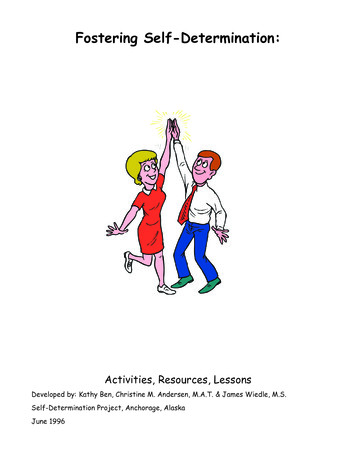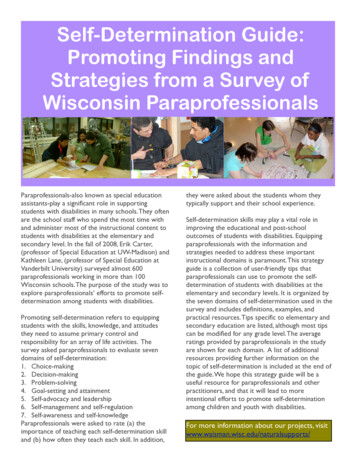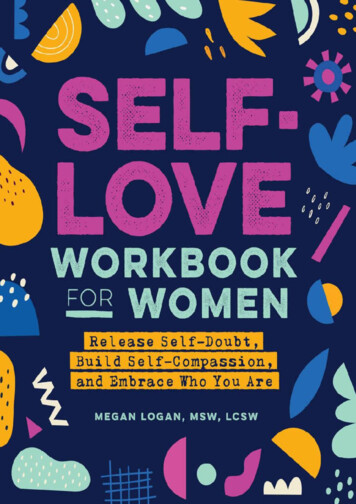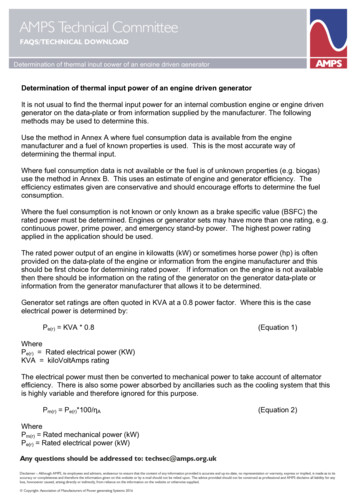
Transcription
Fostering Self-Determination:Activities, Resources, LessonsDeveloped by: Kathy Ben, Christine M. Andersen, M.A.T. & James Wiedle, M.S.Self-Determination Project, Anchorage, AlaskaJune 1996
Fostering Self-Determination
Fostering Self-Determination:Activities, Resources, LessonsDeveloped by: Kathy Ben, Christine M. Andersen, M.A.T. & James Wiedle, M.S.Self-Determination Project, Anchorage, AlaskaJune 1996Our sincere thanks to all the students, parents and educators of the Alternative CareerEducation (ACE) Program who allowed us the opportunity to develop and refine ourmaterials and to the other members of the Life Skills Advisory Board and the Center ForHuman Development for all their assistance and support.Self-Determination ProjectCenter for Human Development2210 Arca DriveAnchorage, AK 99508This guide was created with funding from:United States Department of EducationOffice of Special Education and Rehabilitation ServicesGrant Number H158K30024 1996 Self-Determination Project. Permission is hereby granted for the duplication of allmaterials enclosed herein for educational purposes.Fostering Self-Determination
Fostering Self-Determination
Table of ContentsTable of ContentsIntroduction. 1What is Self-Determination? .3Self-Awareness.5Personal Ads .5Recent and Rad.6Getting to Know You.6What Makes You You?.6?Different Places Different People .7Self-Awareness/Self-Esteem: Class Discussion & Role-plays .7Interests/Abilities .720 Things I Love to Do.7Interpersonal Communication .9Open House .9Where do Values Come From?.9-10LifeStories. 10Public Interview . 10Positive Self-TalkLife Experience Sharing . 10Success Sharing. 10Circle Talks .10-11“What is a Friend?”.11Assertive Communication. 13Effective Communication. 14What is Assertiveness? . 14Compliment/Response Appropriateness. 15-16Goal-Setting. 17Discussion and Role-Plays . 17Setting Short and Long Term Personal Goals. 17Problem-Solving. 19Choices: Class Discussion and Worksheets . 20Choice-making/Consequences: Discussion and Role-plays. 20Problem-Solving: In-Class Discussion Groups . 20Problem-Solving/Decision-Making . 20Personal Futures Planning . 21What is Personal Futures Planning . 21-22Futures Planning Charts . 22“Personal Profile” . 22Personal Futures Planning Session. 22Fostering Self-Determination
Table of Contents“Video Futures. 23What is Video Futures? . 24How Is It Done? . 24Examples . 24What is Video Self-Modeling? . 25Feedforward Self-Modeling . 26Positive Self-Review . 26Why Does Self-Modeling Work? . 26What Types of Behaviors Will Benefit from Self-Modeling? .26-27Appendix . 29WorksheetsMy Twenty Favorites . 30Short Term Personal Goal . 31Long Term Personal Goal. 32Life Choices . 33A Guide for Making Decisions .34-35Personal Futures Planning Guide . 37Student’s History . 38Places Student Goes . 39Student’s Preferences . 40Student’s Strengths . 41Student’s Dreams . 42Student’s Relationships. 43Personal Futures Action Plan . 44Resource Guide.45-48Fostering Self-Determination
IntroductionIntroductionThe materials contained in Fostering Self-Determination are a compilation of activitiesand lesson plans from numerous resources. By no means an exhausted list, our goal increating this guide has been to provide educators with a basic understanding of theconcept of self-determination, and to present a wide variety of sample lessons andcurricula designed to enhance self-determination skills.Some of the activities listed are representative examples of the material we utilizedduring the first school year (‘93-’94) of The Self-Determination Project. In addition, wehave included activities that we have not yet attempted, but believe show great promisefor use in the classroom. Note that we have also enclosed a compilation of additionalresources following the Appendix.We believe the following topics to be the most important elements of selfdetermination: Self-Awareness Interpersonal Communications Assertiveness Goal-Setting Creative Problem-Solving Video-Based Personal Futures Planning Video Self-ModelingA brief introduction opens each section, followed by lessons and activities designed toaddress that particular area of need. We trust you will find this guide useful in yourefforts to enhance the self-determination skills of your students.Fostering Self-Determination1
2Fostering Self-Determination
What is Self-Determination?What is Self-Determination?Self-Determination is the process whereby an individual becomes more independent in: Understanding personal needs and wants Setting goals Planning and following through on action plans to meet goals Learning problem-solving skillsSelf-determined individuals know what they want and how to get it. They advocate fortheir own needs and interests.Fostering Self-Determination3
4Fostering Self-Determination
Self-AwarenessSelf-AwarenessWe have realized that in order for students to become self-determined, they must firstbecome more aware of who they are. Students often have a lot of self-discovery to dobefore they are ready to think beyond the present moment and consider their futures.As they engage in activities to build skills for self-determination, they will gain a greaterknowledge of their own preferences, strengths, and beliefs. One key to making decisionsfor oneself lies in awareness of discrepancies between what is expected and what ishappening in reality. It follows that people must be capable of recognizing what theywould like to occur before it is possible to set goals. By definition, a goal is the differencebetween what is wanted or expected. Students cannot assertively make a request or worktoward their goals if they have not first determined their actual desires.The following are a few lesson ideas designed to affect this process of self-awareness.Personal AdsStudents write advertisements describing themselves for the local newspaper, as thoughthey are looking for a new friend. The advertisement can be up to fourteen wordsonly. Encourage students to think about their personal attributes and to begin theiradvertisement by writing: “I am ” followed by twelve adjectives that they feel describethemselves.Fostering Self-Determination5
Self-AwarenessRecent and RadGo around the room and have each student speak about one “recent and radical” thingthat has happened to him/her in the last week. Possible responses might range from “Iate chocolate cake for breakfast!” to “Someone smiled at me while I was waiting for thebus.” It may surprise students to become aware of all the neat stuff that they may haveoverlooked otherwise!Getting to Know YouThere’s a nasty old lady living in the house/apartment next to yours and she is alwaysgruff and yells at you. You and your friends have played tricks on her several times.Then one day, you find out that she used to have a family of her own, a husband andtwo children, but they were all killed in a fire several years ago. How does this newinformation make you feel? It is important to know how to get to know someone. Have your students generate a list of about 25 questions regarding theinformation it would take to truly begin to know someone.Questions may range from: “Did you grow up in the same house your whole life?” to“What’s the silliest thing you have ever done?” to “How do you think your parents woulddescribe you as a child?” and to “What is your very first memory of school?” One Way tohelp the students brainstorm questions is to have them think about what other peopleshould know about them in order to really know them.The questions may then be used in small groups or between individual students working inpairs.What Makes You You?We are all different. Name five things you are good at and five things you are not so goodat. Going around the room, ask each student to share one thing he/she is good at untileach student has shared two things.Follow up with discussion questions such as: How does it make you feel to be good at something? Do you like to do the things you are good at? When and where do you do those things you are good at? What happens when you have those feelings?Repeat the process with things that the students are not so good at with the facilitatorbeing sure to talk about his/her own weak points as well. Discuss how sometimes westill have to do those things we are not good at and what the benefits are of doing so(increased skill level, stamina, risk-taking, tolerance). What can we do to work aroundsome of the things we are not so good at? (Start earlier, ask for help, be creative, teamup with someone who can, or even barter ) “Concentrate on what you can do and how thatmakes you feel.” Trying your best at something should make you feel good too!Go Further: have the students write a poem or story about themselves. Have themapproach it from the point of view of a salesman with a very important product: ME!6Fostering Self-Determination
Self-AwarenessDifferent Places Different PeopleEach of us mean different things to different people. Discuss how one woman, at thesame time, can be a daughter, a mother, a sister, a wife, a friend, a boss, a coworker,and a subordinate worker. Will she act differently in different situations? How? Is itappropriate for her to act differently? Why?What different roles do you play?Self-Awareness/Self-Esteem: Class Discussion & RoleplaysReview self-awareness and self-esteem and discuss the differences and similaritiesbetween the two concepts.Why is having positive self-esteem important? It provides intrinsic motivation, willingnessto try new things, and helps you accept yourself for who you are.After the discussion, role-play different scenarios, including examples of both positiveand negative self-esteem. Demonstrate both positive and negative self-talk, illustratinghigh and low self-esteem.Interests/AbilitiesDiscuss the differences and similarities between ‘interests’ and ‘abilities’ (Interest issomething you like to do; ability is something you can do.) How does this relate to planningfor the future? Use prepared lists, or have the students generate lists of variousinterests and abilities. Identifying the students’ own interests and abilities from theselists can be done independently, in small groups or as a class, the teacher should beavailable to offer guidance; since young adults may tend to view themselves as inadequate,point out things they can do!Another way to have them express their abilities is to draw them. Some students preferthis media and it will create a greater impact for them.20 Things I Love to DoHave students generate a list of their favorite things to do. * You can begin with a groupbrainstorming session in order to get things moving. Allow students to work with partnersor in small groups, if appropriate. Have the students highlight five favorite activitiesand answer additional questions about those five, to aid in values clarification. Aftercompleting the activity, some discussion topics may include: By doing this activity, I learned that I I was happy to see that I I see that I need/want to Fostering Self-Determination7
8Fostering Self-Determination
Interpersonal CommunicationInterpersonal CommunicationWe all need to be in relationships in order to survive. How does one begin a relationshipor initiate friendship? How do we build and nurture these connections? Communicationis the key – it happens between at least two people and requires several skills, includingactive listening and responding. It is important to learn how to present ourselvespositively but with conviction and confidence; this requires practice. Our non-verbalcommunication tells another person a good deal more about us than the words we choose.In this unit, our goal is to help students become aware of how they are perceived byother people, and to learn how to express themselves more effectively.Open HouseHave students each develop a list of their varying interests/preferences/likes– especially ones that may be quite original, for example: “peanut butter and picklesandwiches,” or “playing snowshoe softball,” etc. Then have the students mingle with eachother “open house” style and find out how many others may share the same interests orbe excited about exploring the interests of another.Where do Values Come From?Facilitate a student discussion around this topic, keeping it on target. Some thoughtprovoking questions: What are values? How old are you when you develop values? Do your parents ever discuss values? Do your friends affect your values?Fostering Self-Determination9
Interpersonal Communication What does peer pressure have to do with values? Are your values the same as your friends’? Can values be taught? What are some outside influences that may affect your values? (TV, newspaper,movies, etc.)Some sources of values: Family, friends, media, school, religion, extended family, rolemodels, etc.Board Game: “LifeStories”Play a commercial board game called LifeStories: *Follow the directions on the gamecards to share thoughts and ideas on different subjects, past experiences, and hopes forthe future.Public Interview Videotape students answering a variety of questions about themselves that arerelated to their hobbies, strengths, values, and dreams. Place list of interview questions on the board. Students should take turns in roles or interviewer, interviewee, and video cameraoperator. Purpose: get to know one another better, develop listening skills, and acquirecamera proficiency.Positive Self-TalkLife Experience Sharing: Mutual self-disclosure develops the trust necessary forstudents to feel secure enough to take risks. The facilitator models the format: specifyan amount of time and share some of your most important life experiences with thegroup. Each student takes his/her turn while other students show respect. Options mayinclude: breaking up into smaller groups or focusing on particular types of memories.Success Sharing: In a format similar to the previous activity, have students discussvarious successes they had with their experiences, breaking it down by age category (010 years old-present, etc.) Some examples of successes may include: learning to walk,talk, spell, swim, sing, play a musical instrument, ride a bicycle, etc. You can reinforce theactivity by occasionally asking the students about their greatest successes of the day,week, or month.*Available from LifeStories, 701 Decatur Avenue North, Suite 104, Golden Valley, MN 55427Circle TalksCircle talks create a supportive environment for an honest expression of feelings. Dividethe class into groups of five or six students and share the topics for discussion andguidelines for this activity. Some guidelines may be: only the person holding a specifiedobject talks, pass object to left, students have the right to “pass” (no pressure to share),10Fostering Self-Determination
Interpersonal Communicationsharing is a personal choice, and no put downs. Students may sometimes choose topics ora situation in class may prompt a circle talk.Examples of possible discussion topics may include: Something I did that helped someone else feel good Something I appreciate about my parents What I do when I get very angry A success I had recently Something I sometimes worry about A person I truly admire – and whyFriendship: “What is a Friend?” – Discussion and Role-playsClass discussion: Define a true friend. List qualities we look for in a friend, distinguishfriends from acquaintances and strangers, give feedback to classmates: “something I likeabout you,” and “something I like about myself that makes me a good friend.” Activitiesmay also include role-plays and videotaping of how true friends behave and how they donot behave.Fostering Self-Determination11
12Fostering Self-Determination
Assertive CommunicationAssertive CommunicationOnce students learn more about their own needs, preferences, desires, and how toexpress themselves effectively, it is then important to discuss and model assertive,aggressive, and passive styles of communication. Passivity as well as aggression can get usinto uncomfortable or dangerous situations. Sharpening assertiveness skills may also leadto discussions of self-advocacy (the pursuit of necessary supports).Some important aspects of assertive communication include: Expressing what you feel is best for you. Standing up for what you believe. Standing up for your rights. Making sure your message is clear so that people understand your needs andideas. Expressing your opinions and feelings in an honest but non-threatening way. Respect other’s rights and opinions, even if they are different from yours. Be a good listener.Fostering Self-Determination13
Assertive CommunicationEffective Communication: Discussion and Role-playsMany difficulties between two people occur because of inadequate or ineffectivecommunication. Use role-plays to show the differences between good (effective) andbad (ineffective) communication. Discuss and create video-taped role play covering thefollowing topics.Communication is not only what we say; it incorporates both verbal and non-verbalcomponents. This includes tone of voice, volume, intonation, posture, eye contact, andother aspects of body language.A good communicator is: patient, thorough, determined, polite, and fair.There are also different styles of communication, such as:1. Assertive: person communicates with strength and respect2. Aggressive: person communicates with aggression and disrespect3. Passive: Person communicates without strengthBarriers to communication may include: not giving enough information, guessing, assuming,interrupting, willingness to listen, making fun of or teasing the speaker.Further activities may include creating various forms of communication, i.e., posters,newspaper advertisements, invitations, billboards, videos, radio, or TV commercials.What is Assertiveness?Assertiveness is being able to inform someone of your needs while still respectingthe needs of others. Characteristics of assertive communication include: listeningto and respecting others, being clear and non-threatening, being ready and willing tocompromise.Assertiveness Skill Building: Present situations for the students to identify aggressive,assertive, and passive behaviors. Discuss the feelings that go along with each type ofbehavior: feelings the person might have about him/herself and feelings that othersmight have about him/her. Discuss specific school, work, or personal situations. Producevideo-taped role-plays using aggressive, assertive, and passive behaviors. Review thevideos and discuss.Compliment/Response AppropriatenessDiscuss the differences between appropriate and inappropriate responses to compliments.Appropriate responses include those that: Value self Value others Say thanks14 Appreciate others’ responsesFostering Self-Determination
Assertive CommunicationInappropriate responses include those that: Express arrogance Are insulting Are put-downs of self or others Express complaint Express sarcasmPresent situations to students so they learn to identify appropriate responses tocompliments. Once they have achieved success in identification, have them generate theirown responses to compliments as they role-play with each other while the rest of thegroup decides whether their responses are appropriate or not.Fostering Self-Determination15
16Fostering Self-Determination
Goal-SettingGoal-SettingAs students learn about their abilities, strengths, and how to communicate theirpreferences; it is important to focus on the pursuit of life goals.Here, we help students: Learn to create a plan with workable steps (i.e., How to set goals and takenecessary steps to achieve goals). Learn to make realistic choices based upon available options.Goal-Setting: Discussion and Role-playsClass discussion: Why is goal-setting important? How does it fit in with selfdetermination? Have the class generate a list of reasons for setting goals. Role-play dailyliving situations both with and without goal-setting.Here are a few examples of reasons that students have generated for why it isimportant to set goals: To help you get somewhere else in life To help you have direction, purpose, and meaning in life To help you get what you want To help you plan out all the needed details To eliminate confusion To help you in the future To be successful To be actively working toward what you really want To help you have security Happiness!Setting Short and Long-Term Personal Goals/WorksheetsClass discussion: What are short-term and long-term personal goals, and how are theydifferent from each other? Work individually (and in pairs) to complete goal-settingworksheets.* Then discuss individual examples with the class.*See worksheets #2 and #3 in AppendixFostering Self-Determination17
18Fostering Self-Determination
Problem-SolvingProblem–SolvingOne important component of self-determination is the area of problem solving.A problem that for one individual may be easily solved, may appear an insurmountableobstacle to someone else. People fail to make quality decisions when they have notacquired sufficient information on available options. The relationship between choicesand their consequences must also be clear. If they are not clear, well-informed decisionscannot be made.Janis and Mann (1977) produced a comprehensive review on effective decision-making.They compiled seven criteria for high quality decision-making (or diligent informationprocessing). They are:1. Thoroughly review a wide range of available options.2. Survey the full range of objectives to be obtained.3. Carefully weigh the positive and negative consequences of each alternative.4. Search for new information and evaluate the alternatives.5. Accurately assimilate new information.6. Re-examine positive and negative consequences of each alternative given thenew information.7. Seek provisions for implementing chosen alternative.It is important to introduce students to all the steps necessary to evaluate a problem, aswell as methods for searching out appropriate alternatives or solutions to the problem.Fostering Self-Determination19
Problem-SolvingChoices: Class Discussion and WorksheetsDefine choice and discuss the different kinds of choices we make daily and weekly,contrasting them with major life decision and choices. Complete “Choices in My Life”worksheet,* and discuss response with the class.Choice-making/Consequences: Discussion and Role-playsClass discussion: how does choice-making enhance self-determination? Define and giveexamples of informed, uninformed, coerced and uncoerced choices. Role-play precarioussituations, identifying choices and the consequences of those choices.Problem-Solving: In-Class Discussion GroupsWhen a difficult issue arises for a particular student, take class time to help thestudent investigate and find possible solutions for the problem by having round tablesupport network with previously-developed guidelines. These guidelines would be similarto a Circle Talk (see interpersonal Communication), where unless life-threatening, theconversations would remain confidential.The student with the difficulty would share his/her concern with the class and otherswould ask clarifying questions. The worksheet “A Guide for Making Decisions” can beutilized at this point.** Once the problem seems clear, fellow students would continue toask questions to help the student identify his/her own solution at hand (to avoid a shiftof focus away from the student with the dilemma).Problem-Solving/Decision MakingDiscuss necessary steps involved in problem-solving. Role-play different problem-solvingtechniques: skills of negotiation, compromise, and conflict resolution. Work throughstudents’ real life problems and videotape the proces
and negative self-esteem. Demonstrate both positive and negative self-talk, illustrating high and low self-esteem. Interests/Abilities Discuss the differences and similarities between 'interests' and 'abilities' (Interest is something you like to do; ability is something you can do.) How does this relate to planning for the future?










